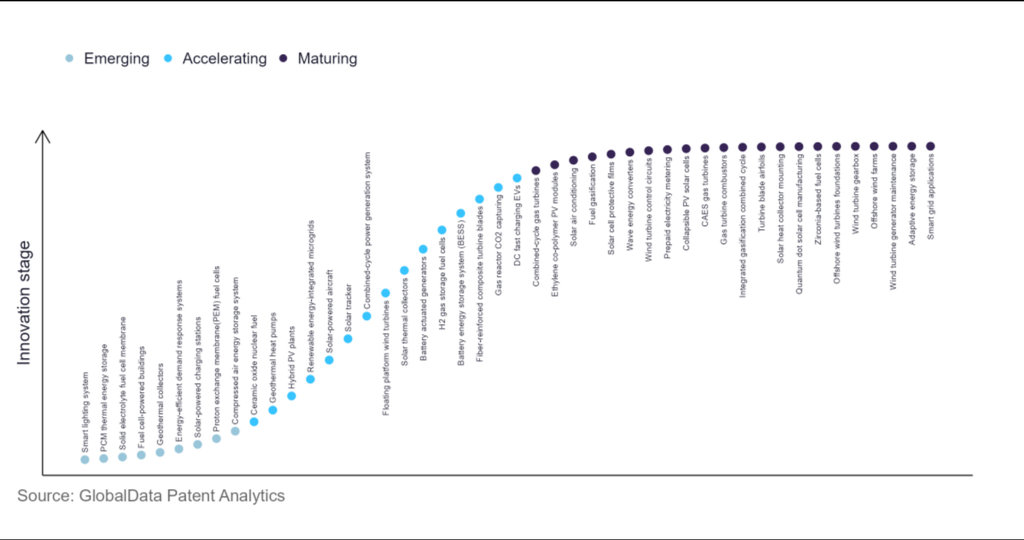The power industry continues to be a hotbed of innovation, with activity driven by land shortage, increasing wind power generation due to rapid urbanisation, the acceleration of sustainable and eco-friendly electricity source, flexibility for relocation and the growing importance of new technologies. In the last three years alone, there have been over 439,000 patents filed and granted in the power industry, according to GlobalData’s report on Environment Sustainability in Power: Floating platform wind turbines.
However, not all innovations are equal, nor do they follow a constant upward trend. Instead, their evolution takes the form of an S-shaped curve that reflects their typical lifecycle from early emergence to accelerating adoption, before finally stabilising and reaching maturity.
Identifying where a particular innovation is on this journey, especially those that are in the emerging and accelerating stages, is essential for understanding their current level of adoption and the likely future trajectory and impact they will have.
90+ innovations will shape the power industry
According to GlobalData’s Technology Foresights, which plots the S-curve for the power industry using innovation intensity models built on over 83,000 patents, there are 90+ innovation areas that will shape the future of the industry.
Within the emerging innovation stage, smart lighting system, PCM thermal energy storage and solid electrolyte fuel cell membrane are disruptive technologies that are in the early stages of application and should be tracked closely. Ceramic oxide nuclear fuel, geothermal heat pumps and hybrid PV plants are some of the accelerating innovation areas, where adoption has been steadily increasing.
Among maturing innovation areas are combined-cycle gas turbines and ethylene co-polymer PV modules, which are now well established in the industry.
Innovation S-curve for environmental sustainability in the power industry

Floating platform wind turbines is a key innovation area in environmental sustainability
A floating wind turbine is an offshore wind turbine which is installed on a floating structure in water body which generates electricity in water depths where fixed-foundation turbines are not viable.
GlobalData’s analysis also uncovers the companies at the forefront of each innovation area and assesses the potential reach and impact of their patenting activity across different applications and geographies. According to GlobalData, there are 40+ companies, spanning technology vendors, established power companies and up-and-coming start-ups engaged in the development and application of floating platform wind turbines.
Key players in floating platform wind turbines – a disruptive innovation in the power industry
‘Application diversity’ measures the number of different applications identified for each relevant patent and broadly splits companies into either ‘niche’ or ‘diversified’ innovators.
‘Geographic reach’ refers to the number of different countries each relevant patent is registered in and reflects the breadth of geographic application intended, ranging from ‘global’ to ‘local’.
Repsol is the leading patent filers in floating wind turbines. Recently, Repsol and Ørsted have signed an agreement to explore joint development of floating offshore wind projects in Spain. This alliance combines Repsol's expertise as global multi-energy provider and Ørsted's experience as the global leader in offshore wind.
In terms of application diversity, Repsol leads the pack. Some other key patent filers in the wind turbine industry include Siemens, Strabag Offshore Wing and EnerOcean. By means of geographic reach, Mitsubishi Heavy Industries held top position, followed by Xinjiang Goldwind Science & Technology and Vestas Wind Systems.
To further understand the key themes and technologies disrupting the power industry, access GlobalData’s latest thematic research report on Power.
GlobalData, the leading provider of industry intelligence, provided the underlying data, research, and analysis used to produce this article.
GlobalData’s Patent Analytics tracks patent filings and grants from official offices around the world. Textual analysis and official patent classifications are used to group patents into key thematic areas and link them to specific companies across the world’s largest industries.